Compact fluorescent lamp
A compact fluorescent lamp (CFL), also called compact fluorescent light, energy-saving light and compact fluorescent tube, is a fluorescent lamp designed to replace an incandescent light bulb; some types fit into light fixtures designed for incandescent bulbs. The lamps use a tube that is curved or folded to fit into the space of an incandescent bulb, and a compact electronic ballast in the base of the lamp.
Compared to general-service incandescent lamps giving the same amount of visible light, CFLs use one-fifth to one-third the electric power, and last eight to fifteen times longer. A CFL has a higher purchase price than an incandescent lamp, but can save over five times its purchase price in electricity costs over the lamp's lifetime.[1] Like all fluorescent lamps, CFLs contain toxic mercury,[2] which complicates their disposal. In many countries, governments have banned the disposal of CFLs together with regular garbage. These countries have established special collection systems for CFLs and other hazardous waste.
The principle of operation remains the same as in other fluorescent lighting: electrons that are bound to mercury atoms are excited to states where they will radiate ultraviolet light as they return to a lower energy level; this emitted ultraviolet light is converted into visible light as it strikes the fluorescent coating, and into heat when absorbed by other materials such as glass.
CFLs radiate a spectral power distribution that is different from that of incandescent lamps. Improved phosphor formulations have improved the perceived color of the light emitted by CFLs, such that some sources rate the best "soft white" CFLs as subjectively similar in color to standard incandescent lamps.[3]
White LED lamps compete with CFLs for high-efficiency lighting.[4] General Electric has since stopped production of domestic CFL lamps in the United States in favour of LEDs.[5]
History
[edit]The parent to the modern fluorescent lamp was invented in the 1890s by Peter Cooper Hewitt.[6] The Cooper Hewitt lamps were used for photographic studios and industries.[6]
Edmund Germer, Friedrich Meyer, and Hans Spanner patented a high-pressure vapor lamp in 1927.[6] George Inman later teamed with General Electric to create a practical fluorescent lamp, sold in 1938 and patented in 1941.[6] Circular and U-shaped lamps were devised to reduce the length of fluorescent light fixtures. The first fluorescent light bulb and fixture were displayed to the general public at the 1939 New York World's Fair.
The spiral CFL was invented in 1976 by Edward E. Hammer, an engineer with General Electric,[7] in response to the 1973 oil crisis.[8] Although the design met its goals, it would have cost GE about $25 million to build new factories to produce the lamps, and thus the invention was shelved.[9] The design was eventually copied by others.[9]
In 1980, Philips introduced its model SL*18, which was a screw-in or bayonet mount lamp with integral magnetic ballast.[10] The lamp used a folded T4 tube, stable tri-color phosphors, and a mercury amalgam. This was the first successful screw-in replacement for an incandescent lamp, using new rare earth aluminum lattice phosphors to solve the problem of lumen depreciation that would normally occur quickly in such a thin tube; however, it was not widely adopted, because of its large size, weight (over half a kilogram), pronounced 50 Hz flicker and 3-minute warm up time.[11] It was based on the SL1000 prototype from 1976.[12] In 1985, Osram started selling its model Dulux EL, which was the first CFL to include an electronic ballast.[13]
Volume was an issue in CFL development, since the fluorescent lamps had to fit in the same volume as comparable incandescent lamps. This required the development of new, high-efficacy phosphors that could withstand more power per unit area than the phosphors used in older, larger fluorescent tubes.[13]
In 1995, helical CFLs, manufactured in China by Shanghai Xiangshan, became commercially available. They were first proposed by General Electric, who saw difficulties bending glass tubes into spirals using automated machinery. Xiangshan solved this problem by bending the tubes by hand, made possible by the then-low labor costs in China.[14] Since that time, sales steadily increased.[15] The phosphor coating in spiral CFLs is uneven, being thicker at the bottom than at the top, owing to the effect of gravity during the coating process.[14] Although their popularity varied across countries, in China CFLs were the "dominant technology in the residential segment" in 2011.[16]
Philips Lighting ceased research on compact fluorescents in 2008 and began devoting the bulk of its research and development budget to solid-state lighting such as LED lighting.[17]
The rise of LED lighting, however, significantly affected CFL sales and production. As a result of decreasing cost and better features, customers increasingly migrated toward LEDs. In India, "nearly 60 per cent of the lighting market ... has been taken over by LEDs" by 2018.[18] LED prices fell well below US$5 for a basic bulb in 2015.[19] In the United States, CFLs were also facing the possibility of proposed regulations for 2017 that would create difficulty qualifying for the Energy Star rating.[19] In early 2016, General Electric announced it would phase out CFL production in the US.[19][5]
On September 1, 2021, the EU banned the export, import, manufacture and sale of all compact fluorescent lamps with integrated ballasts. [20]
-
Philips SL*18, an early CFL
-
A helical integrated CFL, one of the most popular designs in North America since 1995, when a Chinese firm marketed the first successful design[14]
Pattern
[edit]There are two types of CFLs — integrated and non-integrated lamps, where CFL-i denotes an integrated ballast and CFL-ni denotes a non-integrated ballast. Integrated lamps combine the tube and ballast in a single unit. These lamps allow consumers to replace incandescent lamps easily with CFLs. Integrated CFLs work well in many standard incandescent light fixtures, reducing the cost of converting to fluorescent. 3-way lamps and dimmable models with standard bases are available.
Non-integrated CFLs have the ballast permanently installed in the luminaire, and usually only the fluorescent tube is changed at its end of life. Since the ballasts are placed in the light fixture, they are larger and last longer compared to the integrated ones, and they do not need to be replaced when the tube reaches its end-of-life. Non-integrated CFL housings can be both more expensive and sophisticated. They have two types of tubes: a bi-pin tube designed for conventional ballast, e.g. with G23 or G24d plug-in base, and a quad-pin tube designed for an electronic ballast or a conventional ballast with an external starter. A bi-pin tube contains an integrated starter, which obviates the need for external heating pins but causes incompatibility with electronic ballasts. Non-integrated CFLs can also be installed to a conventional light fixture using an adapter containing a built-in magnetic ballast. The adapter consists of a regular bulb screw, the ballast itself and a clip for the lamp's connector.


CFLs have two main components: a magnetic or electronic ballast and a gas-filled tube (also called bulb or burner). Replacement of magnetic ballasts with electronic ballasts has removed most of the flickering and slow starting traditionally associated with fluorescent lighting, and has allowed the development of smaller lamps directly interchangeable with more sizes of incandescent light bulb.
Electronic ballasts contain a small circuit board with a bridge rectifier, a filter capacitor and usually two switching transistors, which are often insulated-gate bipolar transistors. The incoming AC current is first rectified to DC, then converted to high frequency AC by the transistors, connected as a resonant series DC to AC inverter. The resulting high frequency is applied to the lamp tube. Since the resonant converter tends to stabilize lamp current (and light emitted) over a range of input voltages, standard CFLs respond poorly in dimming applications and will experience a shorter lifespan and sometimes catastrophic failure. Special electronic ballasts (integrated or separate) are required for dimming service.
CFL light output is roughly proportional to phosphor surface area, and high output CFLs are often larger than their incandescent equivalents. This means that the CFL may not fit well in existing light fixtures. To fit enough phosphor coated area within the approximate overall dimensions of an incandescent lamp, standard shapes of CFL tube are a helix with one or more turns, multiple parallel tubes, circular arc, or a butterfly.
Some CFLs are labeled not to be run base up, since heat will shorten the ballast's life. Such CFLs are unsuitable for use in pendant lights and especially unsuitable for recessed light fixtures. CFLs designed for use in such fixtures are available.[21] Current recommendations for fully enclosed, unventilated light fixtures (such as those recessed into insulated ceilings), are either to use "reflector CFLs" (R-CFL),[22][23] cold-cathode CFLs or to replace such fixtures with those designed for CFLs.[22] A CFL will thrive in areas that have good airflow, such as in a table lamp.[24]
Characteristics
[edit]Spectrum of light
[edit]

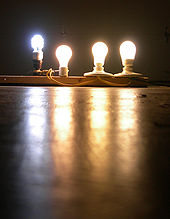
• Compact Fluorescent (General Electric, 13 W, 6500 K)
• Incandescent (Sylvania, 60 W, Extra Soft White)
• Compact Fluorescent (Bright Effects, 15 W, 2644 K
• Compact Fluorescent (Sylvania, 14 W, 3000 K)
CFLs emit light from a mix of phosphors, each emitting one band of color with some bands still in the ultraviolet range as can be seen on the light spectrum. Modern phosphor designs balance the emitted light color, energy efficiency, and cost. Every extra phosphor added to the coating mix improves color rendering but decreases efficiency and increases cost. Good quality consumer CFLs use three or four phosphors to achieve a "white" light with a color rendering index (CRI) of about 80, where the maximum 100 represents the appearance of colors under daylight or other sources of black-body radiation such as an incandescent light bulb (depending on the correlated color temperature).
Color temperature can be indicated in kelvins or mireds (1 million divided by the color temperature in kelvins). The color temperature of a light source is the temperature of a black body that has the same chromaticity (i.e. color) as the light source. A notional temperature, the correlated color temperature, the temperature of a black body that emits light of a hue that to human color perception most closely matches the light from the lamp, is assigned.
The color temperature is characteristic of black-body radiation; practical white light sources approximate the radiation of a black body at a given temperature, but will not have an identical spectrum. In particular, narrow bands of shorter-wavelength radiation are usually present even for lamps of low color temperature ("warm" light).[25]
As color temperature increases, the shading of the white light changes from red to yellow to white to blue. Color names used for modern CFLs and other tri-phosphor lamps vary between manufacturers, unlike the standardized names used with older halophosphate fluorescent lamps. For example, Sylvania's Daylight CFLs have a color temperature of 3500 K, while most other lamps called daylight have color temperatures of at least 5000 K. In United States, Energy Star's specification provides a set of named color temperatures for certified luminaries.
| Name | Color temperature | |
|---|---|---|
| (K) | (Mired) | |
| Soft white | 2700 | 370 |
| Warm white | 3000 | 333 |
| Neutral White | 3500 | 286 |
| Cool white | 4000—4100 | 250—243 |
| Daylight | 5000—6500 | 200—154 |
Lifespan
[edit]CFLs typically have a rated service life of 6000–15,000 hours, whereas standard incandescent lamps have a service life of 750 or 1000 hours.[27][28][29] However, the actual lifetime of any lamp depends on many factors, including operating voltage, manufacturing defects, exposure to voltage spikes, mechanical shock, frequency of cycling on and off, lamp orientation, and ambient operating temperature, among other factors.[30]
The life of a CFL is significantly shorter if it is turned on and off frequently or is used in a totally enclosed fixture. This happens because the electrodes in a CFL undergo sputtering every time it is turned on; this also happens in fluorescent tubes. As a result material from the electrodes is ejected every time sputtering occurs and it is deposited on the fluorescent tube's walls, showing as lamp end darkening. In the case of a 5-minute on/off cycle the lifespan of some CFLs may be reduced to that of incandescent light bulbs. The US Energy Star program suggests that fluorescent lamps be left on when leaving a room for less than 15 minutes to mitigate this problem.[31] CFLs emit less light later in their lives than when they are new. The light output decay is exponential, with the fastest losses being soon after the lamp is first used. By the end of their lives, CFLs can be expected to emit 70–80% of their original light output.[32] The response of the human eye to light is logarithmic. That is, while the human eye is highly sensitive to changes in the intensity of faint light sources, it is less sensitive to changes in the intensity of brighter light sources since the pupils compensate by dilating or constricting.[33] So, presuming the illumination provided by the lamp was ample at the beginning of its life, and the light output of a bulb gradually decreases by 25%, viewers will perceive a much smaller change in light intensity.[34]
Fluorescent lamps get dimmer over their lifetime,[35] so what starts out as an adequate luminosity may become inadequate. In one test by the U.S. Department of Energy, of Energy Star products in 2003–04, one quarter of tested CFLs no longer met their rated output after 40% of their rated service life.[36][37]
Energy efficiency
[edit]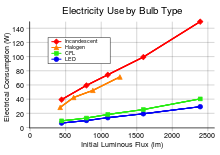
Because the eye's sensitivity changes with the wavelength, the output of lamps is commonly measured in lumens, a measure of the power of light as perceived by the human eye. The luminous efficacy of lamps is the number of lumens emitted for each watt of electric power used. The luminous efficacy of a typical CFL is 50–70 lumens per watt (lm/W) and that of a typical incandescent lamp is 10–17 lm/W.[38] Compared to a theoretical 100%-efficient lamp (680 lm/W), CFL lamps have lighting efficiency ranges of 7–10%,[39] versus 1.5–2.5%[40] for incandescents.[41]
Because of their higher efficacy, CFLs use between one-seventh and one-third of the power of equivalent incandescent lamps.[38] Of 2010 world total lighting sales, 50 to 70 percent were incandescent.[42] Replacing all inefficient lighting with CFLs would save 409 terawatt-hours (1.47 exajoules) per year, 2.5% of world electricity use. In the US, it is estimated that replacing all incandescents would save 80 TWh yearly.[43] Since CFLs use much less energy than incandescent lamps (ILs), a phase-out of ILs would result in less carbon dioxide (CO2) being emitted into the atmosphere. Exchanging ILs for efficient CFLs on a global scale would achieve annual CO2 reductions of 230 Mt (million tons), more than the combined yearly CO2 emissions of the Netherlands and Portugal.[44]
| Minimum light output (lumens) |
Electric power use (watts) | ||
|---|---|---|---|
| Incandescent | Compact fluorescent | LED | |
| 450 | 40 | 9–11 | 6–8 |
| 800 | 60 | 13–15 | 9–12 |
| 1100 | 75 | 18–20 | 13–16 |
| 1600 | 100 | 23–28 | 15–22 |
| 2400 | 150 | 30–52 | 24–28 |
| 3100 | 200 | 49–75 | 30 |
| 4000 | 300 | 75–100 | 38 |
If a building's indoor incandescent lamps are replaced by CFLs, the heat emitted due to lighting is significantly reduced. In warm climates, or in office or industrial buildings where air conditioning is often required, CFLs reduce the load on the cooling system when compared to the use of incandescent lamps, resulting in savings in electricity in addition to the energy efficiency savings of the lamps. However, in cooler climates in which buildings require heating, the heating system must replace the reduced heat from lighting fixtures. In Winnipeg, Canada, it was estimated that CFLs would only generate 17% savings in energy compared to incandescent bulbs, as opposed to the 75% savings that could have been expected without space heating considerations.[46]
Cost
[edit]While the purchase price of a CFL is typically 3–10 times greater than that of an equivalent incandescent lamp, a CFL lasts 8–15 times longer and uses two-thirds to three-quarters less energy. A US article stated "A household that invested $90 in changing 30 fixtures to CFLs would save $440 to $1,500 over the five-year life of the bulbs, depending on your cost of electricity. Look at your utility bill and imagine a 12% discount to estimate the savings."[47]
CFLs are extremely cost-effective in commercial buildings when used to replace incandescent lamps. Using average U.S. commercial electricity and gas rates for 2006, a 2008 article found that replacing each 75 W incandescent lamp with a CFL resulted in yearly savings of $22 in energy usage, reduced HVAC cost, and reduced labour to change lamps. The incremental capital investment of $2 per fixture is typically paid back in about one month. Savings are greater and payback periods shorter in regions with higher electric rates and, to a lesser extent, also in regions with higher than U.S. average cooling requirements.[48] However, frequent on-off cycling (turning on and off) of CFLs greatly reduces their lifespan.
The current price of CFLs reflects the manufacturing of nearly all CFLs in China, where labour costs less. In September 2010, the Winchester, Virginia, General Electric plant closed,[49] leaving Osram Sylvania and the tiny American Light Bulb Manufacturing Inc. the last companies to make standard incandescent bulbs in the United States.[50] At that time, Ellis Yan, whose Chinese company made the majority of CFLs sold in the United States, said he was interested in building a United States factory to make CFL bulbs, but wanted $12.5 million from the U.S. government to do so. General Electric had considered changing one of its bulb plants to make CFLs, but said that even after a $40 million investment in converting a plant, wage differences would mean costs would be 50% higher.[49]
According to an August 2009 newspaper report, some manufacturers claimed that CFLs could be used to replace higher-power incandescent lamps than justified by their light output.[51] Equivalent wattage claims can be replaced by comparison of actual light output emitted by the lamp, which is measured in lumens and marked on the packaging.[52]

Failure
[edit]In addition to the wear-out failure modes common to all fluorescent lamps, the electronic ballast may fail, since it has a number of component parts. Ballast failures are usually due to overheating and may be accompanied by discoloration or distortion of the ballast enclosure, odors, or smoke.[53] The lamps are internally protected and are meant to fail safely at the end of their lives. Industry associations are working toward advising consumers of the different failure modes of CFLs compared to incandescent lamps, and to develop lamps with inoffensive failure modes.[54] New North American technical standards aim to eliminate smoke or excess heat at the end of lamp life.[55]
Dimming
[edit]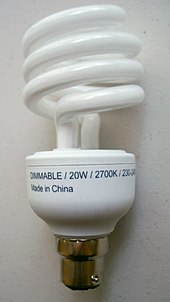
Only some CFLs are labeled for dimming control. Using a dimmer with a standard CFL is ineffective and can shorten bulb life and void the warranty.[56][57] Dimmable CFLs are available. The dimmer switch used in conjunction with a dimmable CFL must be matched to its power consumption range;[58] many dimmers installed for use with incandescent bulbs do not function acceptably below 40 W, whereas CFL applications commonly draw power in the range 7–20 W. Dimmable CFLs have been marketed before suitable dimmers are available. The dimming range of CFLs is usually between 20% and 90%,[59][unreliable source] but many modern CFLs have a dimmable range of 2% to 100%, more akin to that of incandescent lights. There are two types of dimmable CFL on the market: Standard dimmable CFLs, and "switch-dimmable" CFLs. The latter use a standard light switch, and the on-board electronics chooses the light output level based on the number of times the switch is turned on and off quickly. Dimmable CFLs are not a 100% replacement for incandescent fixtures that are dimmed for "mood scenes" such as wall sconces in a dining area. Below the 20% limit, the lamp may remain at 20% or flicker or the starter circuitry may stop and restart.[60] Above 80%, the bulb may operate at 100%. However, recent products have solved these problems so that they perform more like incandescent lamps. Dimmable CFLs are more expensive than standard CFLs due to the additional circuitry.
Cold-cathode CFLs can be dimmed to low levels, making them popular replacements for incandescent bulbs on dimmer circuits.
When a CFL is dimmed, its color temperature (warmth) stays the same. This is counter to incandescent light sources, where color gets redder as the light source gets dimmer. The Kruithof curve from 1934 described an empirical relationship between intensity and color temperature of visually pleasing light sources.[citation needed]
Power factor
[edit]
The input stage of a CFL is a rectifier, which presents a non-linear load to the power supply and introduces harmonic distortion on the current drawn from the supply.[61][62] The use of CFLs in homes has no appreciable effect on power quality, but significant quantities of them in a large facility can have an adverse effect. The power factor of CFLs does not significantly affect their energy-saving benefits for individual consumers, but their use in large numbers, such as in commercial applications or across millions of homes in a distribution system, could require infrastructure upgrades. In such cases, CFLs with low (below 30 percent) total harmonic distortion (THD) and power factors greater than 0.9 should be selected.[63][64][65]
Infrared signals
[edit]Electronic devices operated by infrared remote control can interpret the infrared light emitted by CFLs as a signal; this may limit the use of CFLs near televisions, radios, remote controls, or mobile phones. Energy Star certified CFLs must meet FCC standards, and so are required to list all known incompatibilities on the package.[66][67]
Outdoor use
[edit]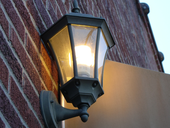
CFLs are generally not designed or rated for outdoor use and some will not start in cold weather. CFLs are available with cold-weather ballasts, which may be rated to as low as −28.8 °C (−20 °F).[68] Light output during the first few minutes of operation is limited at low temperatures before reaching full brightness.[69] Cold-cathode CFLs will start and perform in a wide range of temperatures due to their different design.
Starting time
[edit]Incandescent lamps reach full brightness a fraction of a second after being switched on. As of 2009[update], CFLs turn on within a second, but many still take time to achieve full brightness.[70] The light color may be slightly different immediately after being turned on.[71] Some CFLs are marketed as "instant on" and have no noticeable warm-up period,[72] but others can take up to a minute to reach full brightness,[73] or longer in very cold temperatures. Some that use a mercury amalgam can take up to three minutes to reach full output.[72] This and the shorter life of CFLs when turned on and off for short periods may make CFLs less suitable for applications such as motion-activated lighting. Hybrid lamps, combining a halogen lamp with a CFL, are available where warm up time is unacceptable.[74] The halogen lamp lights immediately, and is switched off once the CFL has reached full brightness.
Health and environmental impact
[edit]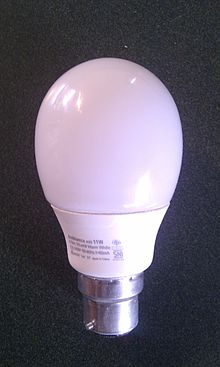
General
[edit]According to the European Commission Scientific Committee on Emerging and Newly Identified Health Risks (SCENIHR) in 2008, CFLs may pose an added health risk due to the ultraviolet and blue light emitted. This radiation could aggravate symptoms in people who already suffer skin conditions that make them exceptionally sensitive to light. The light emitted by some single-envelope CFLs at distances of less than 20 cm (7.9 in) could lead to ultraviolet exposures approaching the current workplace limit set to protect workers from skin and retinal damage. However, industry sources claim the UV radiation received from CFLs is too small to contribute to skin cancer and the use of double-envelope CFLs "largely or entirely" mitigates any other risks.[75]
Tests have shown that radiation exposure from CFLs is negligible at 150 centimeter distance from the source. At closer distances, comparisons show that CFLs emit less UVA (long wavelength) radiation than incandescent light bulbs. They do, however, emit higher levels of UVB (short wavelength) radiation.[76] UVB can penetrate deep into the skin while sufficient levels of UVA can burn superficial layers. Closed (double-envelope) CFLs are shielded and emit a lower total UV radiation compared to incandescent or halogen bulbs of a similar wattage.
For the average user, UV radiation from indoor lights does not appear to be a concern. For those with skin sensitivity long term indoor exposure may be a concern, in which case they may want to use a bulb with lower UV radiation output. There seems to be more variability within bulb types than between them, but the best option is shielded CFLs.
A 2012 study comparing cellular health effects of CFL light and incandescent light found statistically significant cell damage in cultures exposed to CFL light. Spectroscopic analysis confirmed the presence of significant UVA and UVC radiation, which the study's authors conjectured was attributable to damage in the bulbs' internal phosphor coatings. No cellular damage was observed following exposure to incandescent light of equivalent intensity. The study's authors suggest that the ultraviolet exposure could be limited by the use of "double-walled" bulbs manufactured with an additional glass covering surrounding the phosphor-coated layer.[77]
When the base of the bulb is not made to be flame-retardant, as required in the voluntary standard for CFLs, overheating of the electrical components in the bulb may create a fire hazard.[78]
Mercury content
[edit]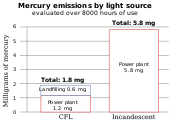
CFLs, like all fluorescent lamps, contain mercury[79][80] as vapor inside the glass tubing. Most CFLs contain 3–5 mg per bulb, with the bulbs labeled "eco-friendly" containing as little as 1 mg.[81][82] Because mercury is poisonous, even these small amounts are a concern for landfills and waste incinerators where the mercury from lamps may be released and contribute to air and water pollution. In the U.S., lighting manufacturer members of the National Electrical Manufacturers Association (NEMA) have voluntarily capped the amount of mercury used in CFLs.[83] In the EU the same cap is required by the RoHS law.
In areas where electric power is mostly generated in coal-fired stations, replacing incandescent bulbs by CFLs actually reduces mercury emissions. This is because the reduced electric power demand, reducing in turn the amount of mercury released by coal as it is burned, more than offsets the amount of mercury released from broken and discarded CFL bulbs.[84] In July 2008 the U.S. EPA published a data sheet stating that the net system emission of mercury for CFL lighting was lower than for incandescent lighting of comparable lumen output. This was based on the average rate of mercury emission for U.S. electricity production and average estimated escape of mercury from a CFL put into a landfill.[85] Coal-fired plants also emit other heavy metals, sulfur, and carbon dioxide.
In the United States, the U.S. Environmental Protection Agency estimated that if all 270 million CFLs sold in 2007 were sent to landfill sites, around 0.13 metric tons of mercury would be released, 0.1% of all U.S. emissions of mercury (around 104 metric tons that year).[86] The graph assumes that CFLs last an average of 8,000 hours regardless of manufacturer and premature breakage. In areas where coal is not used to produce energy, the emissions would be less for both types of bulb.[86]
Special handling instructions for breakage are not printed on the packaging of household CFL bulbs in many countries. The amount of mercury released by one bulb can temporarily exceed U.S. federal guidelines for chronic exposure.[87][88] Chronic, however, implies exposure for a significant time, and it remains unclear what the health risks are from short-term exposure to low levels of elemental mercury.[88] Despite following EPA best-practice clean-up guidelines on broken CFLs, researchers were unable to remove mercury from carpet, and agitation of the carpet — such as by young children playing — created localized concentrations as high as 0.025 mg/m3 in air close to the carpet, even weeks after the initial breakage.[88]
The U.S. Environmental Protection Agency (EPA) has published best practices for cleanup of broken CFLs, and ways to avoid breakage, on its web site.[89] It recommends airing out the room and carefully disposing of broken pieces in a jar. A Maine Department of Environmental Protection (DEP) study of 2008 comparing clean-up methods warns that using plastic bags to store broken CFL bulbs is dangerous, because vapors well above safe levels continue to leak from the bags. The EPA and the Maine DEP recommend a sealed glass jar as the best repository for a broken bulb.[90]
Since the end of 2018, the export, import and manufacture of CFLs within the European Union has been prohibited under the EU Mercury Regulation.[91]
Recycling
[edit]Health and environmental concerns about mercury have prompted many jurisdictions to require spent lamps to be properly disposed of or recycled, rather than being included in the general waste stream sent to landfills. Safe disposal requires storing the bulbs unbroken until they can be processed.
In the United States, most states have adopted and currently implement the federal Universal Waste Rule (UWR).[92] Several states, including Vermont, New Hampshire, California, Minnesota, New York, Maine, Connecticut and Rhode Island, have regulations that are more stringent than the federal UWR.[92] Home-supply chain stores make free CFL recycling widely available.[93]
In the European Union, CFLs are one of many products subject to the WEEE recycling scheme. The retail price includes an amount to pay for recycling, and manufacturers and importers have an obligation to collect and recycle CFLs.
According to the Northwest Compact Fluorescent Lamp Recycling Project, because household users in the U.S. Northwest have the option of disposing of these products in the same way they dispose of other solid waste, in Oregon "a large majority of household CFLs are going to municipal solid waste". They also note the EPA's estimates for the percentage of fluorescent lamps' total mercury released when they are disposed of in the following ways: municipal waste landfill 3.2%, recycling 3%, municipal waste incineration 17.55% and hazardous waste disposal 0.2%.[94]
The first step of processing CFLs involves crushing the bulbs in a machine that uses negative pressure ventilation and a mercury-absorbing filter or cold trap to contain mercury vapor. Many municipalities are purchasing such machines.[citation needed] The crushed glass and metal is stored in drums, ready for shipping to recycling factories.
Greenhouse gases
[edit]In some places, such as Quebec and British Columbia in 2007, central heating for homes was provided mostly by the burning of natural gas, whereas electricity was primarily provided by hydroelectric power. An analysis of the impacts of a ban on incandescent light bulbs at that time introduced the notion that in such areas, heat generated by conventional electric light bulbs may have been significantly reducing the release of greenhouse gases from natural gas heating.[95] Ivanco, Karney, and Waher estimated that "If all homes in Quebec were required to switch from (incandescent) bulbs to CFLs, there would be an increase of almost 220,000 tonnes in CO2 emissions in the province, equivalent to the annual emissions from more than 40,000 automobiles."
Use and adoption
[edit]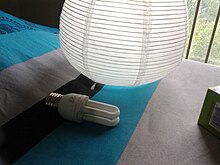
CFLs are produced for both alternating current (AC) and direct current (DC) input. DC CFLs are popular for use in recreational vehicles and off-the-grid housing. Various aid agency initiatives exist in developing countries to replace kerosene lamps, which have associated health and safety hazards, with CFLs powered by batteries, solar panels or wind power generators.[96]
Due to the potential to reduce electric consumption and pollution, various organizations have encouraged the adoption of CFLs and other efficient lighting. Efforts range from publicity to encourage awareness, to direct handouts of CFLs to the public. Some electric utilities and local governments have subsidized CFLs or provided them free to customers as a means to reduce electric demand; and so delay further investments in generation.
In the United States, the Program for the Evaluation and Analysis of Residential Lighting (PEARL) was created to be a watchdog program. PEARL has evaluated the performance and Energy Star compliance of more than 150 models of CFL bulbs.[97][98]
The UN Environment Programme (UNEP)/Global Environment Facility (GEF) initiative has developed "The Global Efficient Partnership Program", which focuses on country-led policies and approaches to enable the implementation of energy-efficient lighting, including CFLs, quickly and cost-effectively in developing and emerging countries.
In the United States and Canada, the Energy Star program labels lamps that meet a set of standards for efficiency, starting time, life expectancy, color, and consistency of performance. The intent of the program is to reduce consumer concerns due to variable quality of products.[99] Those CFLs with a recent Energy Star certification start in less than one second and do not flicker. Energy Star Light Bulbs for Consumers is a resource for finding and comparing Energy Star qualified lamps. There is ongoing work in improving the "quality" (color rendering index) of the light.[citation needed]
In the United States, new standards proposed by the United States Department of Energy could result in LED lamps replacing CFLs. In the opinion of Noah Horowitz of the Natural Resources Defense Council, most CFL bulbs would not meet the standards.[100]
In the United Kingdom, a similar program is run by the Energy Saving Trust to identify lighting products that meet energy conservation and performance guidelines.[101]
The G24 (624Q2) and GU24 lamp fitting socket systems were designed to replace the traditional lamp sockets, so that incandescent bulbs are not installed in fixtures intended for energy efficient lamps only.
Efficiency comparison
[edit]This section needs additional citations for verification. (November 2015) |
| Incandescent | Halogen | Fluorescent | LED | ||||
| Generic | Philips | Philips L Prize[102] | Daylight (TCP) | ||||
| Electric power (W) | 60 | 42 | 14 | 10 | 12.5 | 9.7 | 9.8 |
| Light output (lm) | 860 | 650 | 800 | 800 | 800 | 910 | 950 |
| Luminous efficacy (lm/W) | 14.3 | 14.42 | 57.14 | 80 | 64 | 93.4 | 96.94 |
| Color temperature (K) | 2700 | 3100[103] | 2700 | 3000 | 2700 | 2727 | 5000 |
| CRI | 100 | 100 | >75 | >85 | 85 | 93 | Not listed |
| Lifespan (h) | 1000 | 2500 | 8000 | 25,000 | 25,000 | 30,000 | 25,000 |
See also
[edit]References
[edit]- ^ "Compact Fluorescent Light Bulbs". Energy Star. Archived from the original on 2008-09-16. Retrieved 2010-09-30.
- ^ "CFL Bulbs Have One Hitch: Toxic Mercury". National Public Radio. Retrieved 2007-02-15.
- ^ Masamitsu, Emily (May 2007). "The Best Compact Fluorescent Light Bulbs: PM Lab Test". Popular Mechanics. Archived from the original on April 26, 2007. Retrieved 2007-05-15.
- ^ Amber Angelle, "Will LED Light Bulbs Best Your CFLs and Incandescents?" Popular Mechanics August 4, 2010 accessed May 30, 2011
- ^ a b "Say Goodbye. Say Hello". February 2016. Archived from the original on 2016-10-22. Retrieved 2016-12-19.
- ^ a b c d Bellis, Mary (2007). "The History of Fluorescent Lights". About.com. Archived from the original on 2012-04-27. Retrieved 2008-02-13.
- ^ "Inventing Six Modern Electric Lamps: Compact Fluorescent – The Challenge of Manufacturing". National Museum of American History. Retrieved 18 June 2013.
- ^ Segall, Grant (20 July 2012). "Edward E. Hammer of Nela Park invented compact fluorescent light bulbs: news obituary". Cleveland.com. Sun Newspapers. Retrieved 18 June 2013.
- ^ a b Kanellos, Michael (August 2007). "Father of the compact fluorescent bulb looks back". CNet News. Archived from the original on 2008-05-11. Retrieved 2007-07-17.
- ^ Bell, John (17 March 1983). "The Art and Craft of Fluorescent Lamps". New Scientist. Vol. 97, no. 1349. p. 719.
- ^ "Philips SL*18". www.lamptech.co.uk. Retrieved 2020-12-11.
- ^ "Philips SL1000". www.lamptech.co.uk. Retrieved 2020-12-11.
- ^ a b Kane, Raymond; Sell, Heinz (2001). Revolution in Lamps: A Chronicle of 50 Years of Progress (Second ed.). The Fairmont Press. pp. 189–190. ISBN 978-0-88173-378-5.
- ^ a b c "Philips Tornado Asian Compact Fluorescent". Lamptech.co.uk. Retrieved 18 June 2013.
- ^ "Barriers to Technology Diffusion: The Case of Compact Fluorescent Lamps" (PDF). Organisation For Economic co-Operation And Development. 30 October 2006. Archived (PDF) from the original on 2015-09-12.
- ^ Lighting the Way: Perspectives on the global lighting market (PDF) (Second ed.), McKinsey & Company, Inc., August 2012, p. 29, retrieved 12 January 2019
- ^ "Fans of L.E.D.'s Say This Bulb's Time Has Come". The New York Times. 28 July 2008.
- ^ Pratap, Rashmi (10 January 2018). "As LEDs burn bright, it'll soon be lights out for CFL bulbs". The Hindu Business Line. The Hindu. Retrieved 12 January 2019.
- ^ a b c Cardwell, Diane (1 February 2016). "G.E. to Phase Out CFL Bulbs". The New York Times. Archived from the original on 16 February 2016. Retrieved 31 August 2016.
- ^ "ecodesign requirements for light sources and separate control gears". eur-lex.europa.eu. Retrieved 2023-06-30.
- ^ What Compact Fluorescents to Use Where. Accessed 1 January 2008.
- ^ a b "A Dealer Guide to Energy Star: Putting Energy into Profits" (PDF). Archived from the original (PDF) on 2017-04-30. Retrieved 2007-10-09.
- ^ "CFL Reflector Products". Pacific Northwest National Laboratory. 2007-10-02. Archived from the original on December 21, 2007. Retrieved 2007-12-24.
- ^ "Press Releases | LRC Newsroom". Lrc.rpi.edu. 2009-03-16. Archived from the original on 2012-07-24. Retrieved 2012-07-15.
- ^ Buying and Selling Gems:What Light is Best? Part II: Artificial Light – The Options Available See figures 6 and 7
- ^ "Energy Star Program Requirements Product Specification for Luminaires 2.0" (PDF). Retrieved 4 June 2017.
- ^ General Electric Incandescent lamps TP110, technical pamphlet published in 1976, no ISBN or Library of Congress number, page 8
- ^ "Osram Dulux EL Energy-Saving Lamps" (PDF). Osram. Archived from the original (PDF) on 2006-07-22. Retrieved 2007-12-24.
- ^ "IEC 60969: Self-ballasted lamps for general lighting services: Performance requirements". Collaborative Labelling and Appliance Standards Program. Archived from the original on February 26, 2008. Retrieved 2007-12-24.
- ^ Damir, B (2012). "Longevity of light bulbs and how to make them last longer". RobAid. Archived from the original on 19 August 2015. Retrieved 4 January 2013.
- ^ "When to turn off your lights". Energy Saver. United States Department of Energy. Retrieved 2017-07-22.
- ^ Guan, Fumin; Reynolds, Dale (May 2005). Topic and Discussions on the Performance Standard and Inspection Methods of CFL. Right Light 6: 6th International Conference on Energy-Efficient Lighting. Archived from the original on September 23, 2007.
- ^ Halsted, Charles P. (March 1993). "Brightness, Luminance, and Confusion". Information Display. Naval Air Warfare Center Warminster, PA. Archived from the original on September 22, 2007. Retrieved 2007-10-07.
If the luminance of a viewed light source is increased 10 times, viewers do not judge that the brightness has increased 10 times. The relationship is, in fact, logarithmic: the sensitivity of the eye decreases rapidly as the luminance of the source increases. It is this characteristic that allows the human eye to operate over such an extremely wide range of light levels.
- ^ Matković, Krešimir (December 1997). Colour Science Basics: Human Vision. Tone Mapping Techniques and Color Image Difference in Global Illumination (PhD). Institut für Computergraphik eingereicht an der Technische Universität Wien (TU Wien). Archived from the original on 2021-06-09. Retrieved 2007-10-07.
It is interesting, that despite that incoming light can have a dynamic range of nearly 14 log units, the neural units can transfer the signal having the dynamic range of only about 1.5 log units. It is obvious that there is some adaptation mechanism involved in our vision. It means that we adapt to some luminance value, and then we can perceive data in a certain dynamic range near the adaptation level. One of the most important characteristics that changes with different adaptation levels is the just noticeable difference.
- ^ "Topic and Discussions on the Performance Standard and Inspection Methods of CFL" (PDF). Archived from the original (PDF) on September 27, 2007. Retrieved 2007-04-13.
- ^ O'Rourke, Conan; Zhou, Yutao (2006). "Energy Star Lighting Verification Program (Program for the Evaluation and Analysis of Residential Lighting) Semi-annual report For the period of October 2003 to April 2004" (PDF). doi:10.2172/881039. Retrieved 2007-04-13.
{{cite journal}}: Cite journal requires|journal=(help) - ^ "Quality Assurance in Energy Star Residential Lighting Programmes" (PDF). Archived from the original (PDF) on December 9, 2006. Retrieved 2007-04-13.
- ^ a b "Lighting". Energy Efficiency & Renewable Energy. United States Department of Energy. Archived from the original on October 15, 2011. Retrieved 2 October 2011.
- ^ 50/680 = 7%; 70/680 = 10%
- ^ 10/680 = 1.5%; 17/680 = 2.5%
- ^ Keefe, T. J. (2007). "The Nature of Light". Community College of Rhode Island. Archived from the original on June 12, 2010. Retrieved 18 September 2010.
- ^ "Multibillion dollar benefits of global switch to energy-efficient lighting" (Press release). United Nations Environment Programme. 1 Dec 2010. Archived from the original on 14 August 2016. Retrieved 2 October 2011.
- ^ "United States of America". En.lighten. United Nations Environment Programme. 2010. Archived from the original on April 2, 2012. Retrieved 2 October 2011.
- ^ "Climate Change Mitigation Benefits". www.enlighten-initiative.org. Archived from the original on August 2, 2013.
- ^ "Learn About Light Output: Energy Star". Energystar.gov. Retrieved 2012-07-15.
- ^ "Efficient lighting equals higher heat bills: study". CBC News. 2009-03-04.
- ^ Lavelle, Marianne (19 December 2007). "FAQ: The End of the Light Bulb as We Know It". U.S. News & World Report.
- ^ Chernoff, Harry (2008-01-23). "The Cost-Effectiveness of Compact Fluorescents in Commercial Buildings". EnergyPulse. Archived from the original on February 20, 2008. Retrieved 2008-03-21.
- ^ a b Whoriskey, Peter (2010-09-08). "Light bulb factory closes; End of era for U.S. means more jobs overseas". The Washington Post. Retrieved 2011-06-02.
- ^ Davenport, Jim (28 March 2011). "SC lawmakers take dim view of new light bulbs". NBC News. Archived from the original on March 13, 2020.
- ^ Gray, Richard; McWatt, Julia (29 August 2009). "Energy saving light bulbs offer dim future". The Telegraph. Archived from the original on 2022-01-12.
- ^ "Section III.3". Europa.eu. Retrieved 2012-07-15.
- ^ Compact Fluorescent Lights, Halifax Regional Fire & Emergency Archived May 20, 2013, at the Wayback Machine
- ^ National Electrical Manufacturer's Association NEMA, Failure Modes for Self-Ballasted Compact Fluorescent Lamps (requires account) Archived March 22, 2012, at the Wayback Machine, white paper no. LSD 40, retrieved 2008-06-26.
- ^ "New household lamp standards, discusses co-ordinated U.S., Mexico and Canada standard UL 1993, retrieved 2009 Dec 3". Csa.ca. Archived from the original on 2012-03-15. Retrieved 2012-07-15.
- ^ GE Lighting FAQ for CFL retrieved 12 March 2007 Archived June 26, 2012, at the Wayback Machine
- ^ "CFL Warranty: Energy Star". www.energystar.gov. Archived from the original on 2020-03-16. Retrieved 2019-12-18.
- ^ "Dimming CFLs and LEDs". www.lutron.com.
- ^ "Dimmable CFLs". Dimmable CFLs. Archived from the original on 2012-06-21. Retrieved 2012-07-15.
- ^ Yau, E. K. F.; Wing-Hung Ki; Mok, P. K. T.; Sin, J. K. O. (2001). "Phase-controlled dimmable CFL with PPFC and switching frequency modulation". 2001 IEEE 32nd Annual Power Electronics Specialists Conference (IEEE Cat. No.01CH37230). Vol. 2. p. 951. doi:10.1109/PESC.2001.954241. ISBN 978-0-7803-7067-8. S2CID 109878618.
- ^ Korovesis, Ph. N.; et al. (2004). "Influence of Large-Scale Installation of Energy Saving Lamps on the Line Voltage Distortion of a Weak Network Supplied by Photovoltaic Station". IEEE Transactions on Power Delivery. 19 (4): 1787–1793. doi:10.1109/TPWRD.2004.835432. S2CID 19975088.
- ^ Cunill-Solà, J.; Salichs, M. (2007). "Study and Characterization of Waveforms from Low-Watt (<25 W) Compact Fluorescent Lamps with Electronic Ballasts". IEEE Transactions on Power Delivery. 22 (4): 2305–2311. doi:10.1109/TPWRD.2007.899551. S2CID 11439733.
- ^ "Compact Fluorescent Lamps". Mge.com. Archived from the original on 2012-03-14. Retrieved 2012-07-15.
- ^ Anibal T. De Almeida: Understanding Power Quality Archived 2011-07-26 at the Wayback Machine, Home Energy Magazine
- ^ Fernstrom, Gary B. (June 19, 2007). Residential Lighting Improvement Opportunities (PDF) (Report). California Energy Commission. Archived from the original (PDF) on July 23, 2012.
Joint Committee Workshop on Policies to Improve Residential Lighting Efficiency in California
- ^ Can CFLs interfere with electronic equipment? Archived October 29, 2010, at the Wayback Machine at ConsumerReports.org. Accessed 1 January 2008.
- ^ "Compact Fluorescent Light Bulbs Key Product Criteria: Energy Star". Energystar.gov. 2008-12-02. Archived from the original on 2012-07-13. Retrieved 2012-07-15.
- ^ "Coming to Terms with Energy Efficiency and the Environment". The Clean Air Partnership. Archived from the original on October 11, 2007.
- ^ U.S. Dept. of Energy, Greening Federal Facilities, 2nd Edition, 'Compact Fluorescent Lighting Archived May 11, 2011, at the Wayback Machine'. DOE/GO=102001-1165 page 87. Retrieved 22 February 2007. "Even when low-temperature ballasts are used, lamps will not reach full brightness for several minutes in cold weather."
- ^ "Why does my compact fluorescent light bulb flicker or appear dim when I first turn it on?". Compact Fluorescent Light Bulb (CFL) FAQs. GE Lighting. Archived from the original on February 28, 2009. Retrieved 2009-06-15.
- ^ "GE Lighting Frequently Asked Questions — Compact Fluorescent (CFL): 4. Can I use a CFL in applications where I will be turning the lights on/off frequently?". Archived from the original on March 29, 2007. Retrieved 2007-04-13.
- ^ a b "I've noticed some CFLs need a few minutes to warm up, or reach full brightness ..." Customer Help FAQ. Energy Star. Archived from the original on 2017-03-24. Retrieved 2009-06-15.
{{cite web}}: CS1 maint: bot: original URL status unknown (link) - ^ "Why does it take time for CFL bulbs to come up to full brightness?". Efficient Lighting FAQs. City of Fort Collins. Archived from the original on December 10, 2008. Retrieved 2009-06-15.
- ^ "GE Lighting to promote halogen-CFL hybrid bulb with Target". 5 September 2013.
- ^ "Energy-Saving Lamps & Health". GreenFacts site. Retrieved 2009-06-10.
- ^ Nuzum-Keim, AD; Sontheimer, RD (2009). "Ultraviolet light output of compact fluorescent lamps: comparison to conventional incandescent and halogen residential lighting sources". Lupus. 18 (6): 556–60. doi:10.1177/0961203309103052. PMID 19395458. S2CID 206597819.
- ^ Mironava, T.; Hadjiargyrou, M.; Simon, M.; Rafailovich, M. H. (20 Jul 2012). "The Effects of UV Emission from Compact Fluorescent Light Exposure on Human Dermal Fibroblasts and Keratinocytes In Vitro". Photochemistry and Photobiology. 88 (6): 1497–1506. doi:10.1111/j.1751-1097.2012.01192.x. PMID 22724459. S2CID 2626216.
- ^ CPSC, Teng Fei Trading Inc. Announce Recall of Energy Saving Light Bulbs Archived January 8, 2013, at the Wayback Machine. U.S. Consumer Product Safety Commission press release. Accessed 1 January 2008.
- ^ "Mercury Content Information Available for Lamps on the 2003 New Jersey Contract T-0192". Archived from the original on 2005-12-30. Retrieved 2007-05-15.
- ^ "Canada-Wide Standard for Mercury-Containing Lamps" (PDF). 2001. Archived from the original (PDF) on August 12, 2006. Retrieved 2007-03-23.
- ^ "Frequently Asked Questions Information on Compact Fluorescent Light Bulbs (CFLs) and Mercury June 2008" (PDF). 2008. Retrieved 2008-08-31.
- ^ "Mercury in Fluorescent Lamps". FAQ. Energy Federation Incorporated. Archived from the original on 2009-08-10. Retrieved 2009-07-02.
- ^ "NEMA Lamp Companies Announce Commitment to Cap CFL Mercury Content". Archived from the original on July 15, 2007. Retrieved 2007-03-23.
- ^ "Frequently Asked Questions, Information on Proper Disposal of Compact Fluorescent Light Bulbs (CFLs)" (PDF). Retrieved 2007-03-19.
- ^ "Frequently Asked Questions Information on Compact Fluorescent Light Bulbs (CFLs) and Mercury July 2008, accessed 2009 Dec 22" (PDF). Retrieved 2012-07-15.
- ^ a b "Frequently Asked Questions: Information on Compact Fluorescent Light Bulbs (CFLs) and Mercury" (PDF). energystar.gov. November 2010. Retrieved 2017-03-23.
What are the mercury emissions caused by humans? Do CFLS that wind up in a landfill contribute to these emissions?
- ^ Daley, Beth (February 26, 2008). "Mercury leaks found as new bulbs break". The Boston Globe. Retrieved 2009-03-07.
- ^ a b c "Maine Compact Fluorescent Lamp Breakage Study Report". State of Maine, Dept of Environmental Protection. February 2008. Retrieved 2009-03-07.
- ^ "Cleaning Up a Broken CFL". United States Environmental Protection Agency. 6 June 2013. Archived from the original on 7 December 2021. Retrieved 18 June 2013.
- ^ "Maine Compact Fluorescent Light Breakage Study Report". Maine Department of Environmental Protection. February 2008. Retrieved 2011-07-18.
- ^ "Progressive ban on mercury-containing products". bmuv. January 2018. Retrieved 2022-10-08.
- ^ a b "How are mercury-containing bulbs (called "lamps" in the regulations) regulated?". United States Environmental Protection Agency. 10 May 2013. Retrieved 18 June 2013.
- ^ Rosenbloom, Stephanie (24 June 2008). "Home Depot Offers Recycling for Compact Fluorescent Bulbs". The New York Times. Retrieved 18 June 2013.
- ^ "Compact Fluorescent Lamp Recycling Project Phase I Draft Report Background Research and Program Options" (PDF). Archived from the original (PDF) on 2007-09-27.
- ^ Ivanco, M.; Karney, B.W.; Waher, K.J. (25–26 October 2007). To Switch, or Not to Switch: A Critical Analysis of Canada's Ban on Incandescent Light Bulbs. IEEE Electrical Power Conference. pp. 550–555. doi:10.1109/EPC.2007.4520391.
- ^ 200 0000+ solar powered kerosene-lamp replacements assisted by aid agencies: http://www.ashdenawards.org/winners/mpgvm Archived 2011-05-11 at the Wayback Machine, http://www.ashdenawards.org/winners/Dlight10 Archived 2010-07-08 at the Wayback Machine, "Archived copy" (PDF). Archived from the original (PDF) on 2011-05-12. Retrieved 2010-06-30.
{{cite web}}: CS1 maint: archived copy as title (link) - ^ "Program for Evaluation and Analysis of Residential Lighting (PEARL): Programs: LRC". Lrc.rpi.edu. Archived from the original on 2012-07-24. Retrieved 2012-07-15.
- ^ "Archived copy" (PDF). Archived from the original (PDF) on 2010-06-13. Retrieved 2010-04-20.
{{cite web}}: CS1 maint: archived copy as title (link) - ^ Energy Star Program Requirements for CFLS Partner Commitments, 4th edition, dated 3 July 2008, retrieved 2008-06-25.
- ^ Wolverton, Troy (2016-03-12). "Be prepared to say goodbye to the lightbulbs you've loved". The Charlotte Observer. San Jose Mercury News. p. 1C.
- ^ "Energy saving lightbulbs". Energysavingtrust.org.uk. Archived from the original on 2011-07-26. Retrieved 2012-07-15.
- ^ "LPrize-winner_media-kit.pdf" (PDF). U.S. Department of Energy. Archived from the original on 6 October 2011. Retrieved 11 March 2013.
- ^ 3100K is typical; individual bulbs vary. See Temperature of a Halogen Light Bulb, The Physics Factbook, Glenn Elert, ed., (Retrieved 2012-05-12)
External links
[edit]- CFL Bulb and Base Reference Guide
- Plug-In Plug-in CFL (PL Type) Lamps: Non-integrated Bulbs – cross reference listing of non-integrated CFL bulbs
- A technical description of a typical CFL circuit

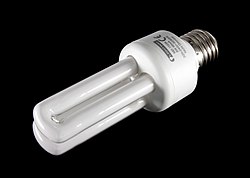
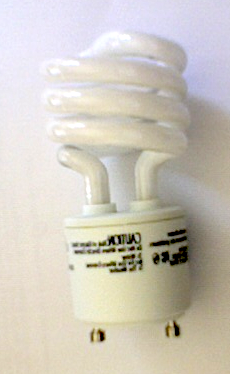


![A helical integrated CFL, one of the most popular designs in North America since 1995, when a Chinese firm marketed the first successful design[14]](http://upload.wikimedia.org/wikipedia/commons/thumb/c/c3/Compact-Fluorescent-Bulb.jpg/181px-Compact-Fluorescent-Bulb.jpg)